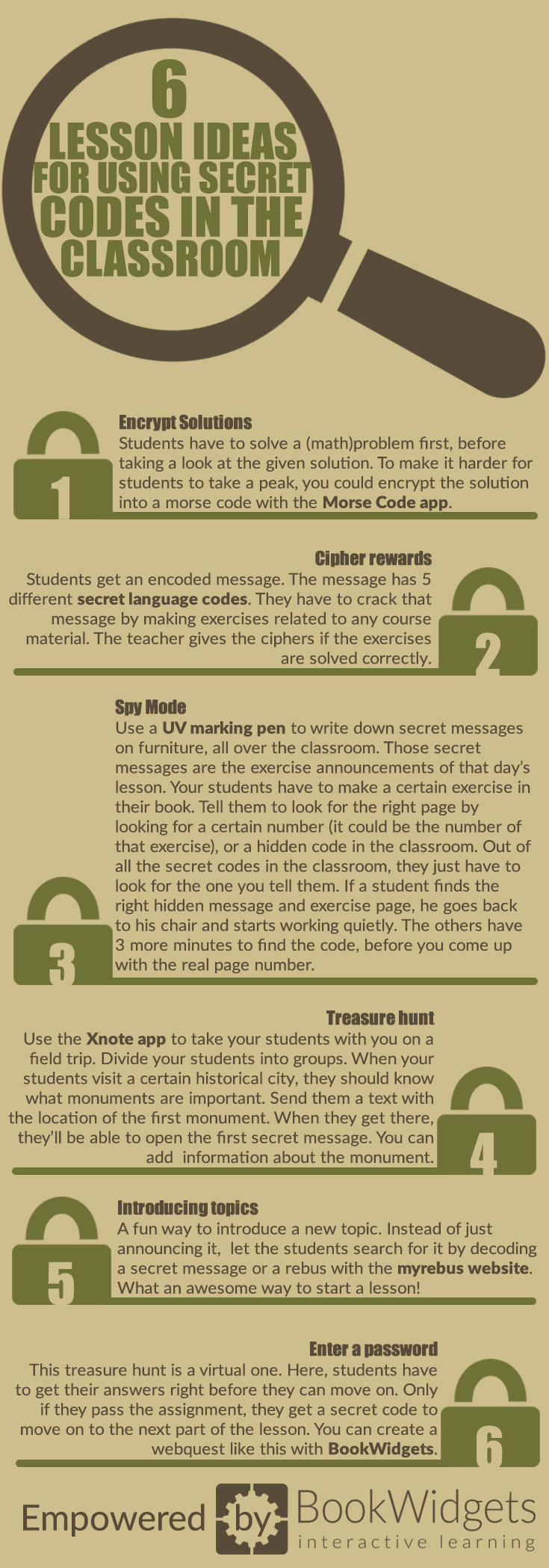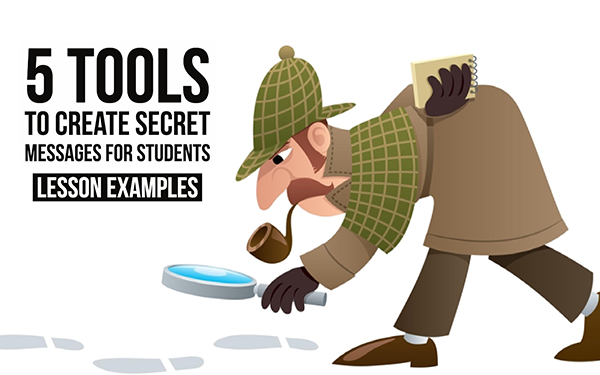Using secret messages in the classroom - The best tools and lesson ideas
 Lucie Renard —
Lucie Renard —
Students are solving problems all day. They are true detectives. Woudn’t it be fun to encourage that even more?
In this blog post I’ll mention some fun tools that are the perfect fit for creating secret messages and codes. On top of that, I’ll show you what you can do with these encrypted messages in your classroom.
Ready? Spy mode: on!
5 tools to create secret messages for students
Take a look at these 5 fun cryptic message generators. They are all very easy to use.
1. My Rebus
My Rebus is a secret code maker website that creates, take a guess, rebuses. Just enter the sentence you would like the app to translate into a rebus riddle, choose a difficulty level and click on “create rebus”. That’s it. The website will automatically create a rebus. Here’s an example, can you encrypt the hidden sentence?

2. Morse Code
With this morse code app, you can create a Morse code out of a sentence. Students can also decrypt a morse code sentence. They can use the decoder and type in the morse code, or they can use the secret message decoder or the morse code alphabet to find out the sentence.
Example: - …. .. … / .- .–. .–. / .. … / .-…- .-.. .-.. -.– / ..- … . ..-. ..- .-..
3. UV marking pen
There a pens to write down invisible messages with invisible ink on your student’s papers. To decipher the message, students will need to go over the text with a UV light. This way, the secret message will appear. Very cool!
4. Xnote
This app isn’t without any costs, but it is very engaging and fun! With Xnote, your students go on a virtual treasure hunt to find your hidden message. Xnote allows you to hide virtual messages (with or without pictures) anywhere in the world. The students that receive the message have to physically go to that spot to be able to read the message. You can even chain messages to create an extended treasure hunt.
5. Secret code generator
Of course, there are so many secret languages that have been created over the years. take a look at these 8 secret code examples.
All the hard work has already been done for you. Just download the files, open them in Adobe Reader, type in your own secret message and it will automatically encrypt the message to match the corresponding Cipher card. It’s actually a secret language message maker with the matching ciphers for kids.
Each of the codes requires the students to think differently. Some codes are well-known secret codes, while others are unique ones that the author has come up with and created special fonts for.
Using secret codes in your lessons - examples
Using these secret codes in your lessons is definitely so much fun, but what educational value do they have? Let me give you some lesson ideas in which you can use fun hidden messages.
1. Encrypt solutions
Encrypt the solution of an exercise. Students have to solve a (math)problem first, before taking a look at the given solution. To make it harder for students to take a peek, you could encrypt the solution into a morse code or other code.
2. Cipher rewards
Students get an encoded message. The goal: to crack that message. How: by making math exercises, speaking exercises, … (related to any course material). The message has 5 different secret language codes. To get the ciphers, students make exercises. The teacher gives the ciphers if they solved the exercises correctly.
3. Spy mode
Use the UV marking pen to write down secret messages on classroom furniture, all over the place. Those secret messages are actually just the exercise announcements of that day’s lesson. For example: your students have to make a certain exercise in their book. Tell them to look for the right page by looking for a certain number (it could be the number of that exercise), or a hidden code in the classroom. Out of all the secret codes in the classroom, they just have to look for the one you tell them. If a student finds the right hidden message and exercise page, he goes back to his chair and starts working quietly. The others have 3 more minutes to find the code, before you, the teacher, comes up with the page number.
4. Treasure hunt
Use the Xnote app to take your students with you on a field trip. Divide your students into groups. When your students visit a certain historical city, they should know what monuments to visit. Send them a text with the location of the first monument. When they get there, they’ll be able to open the first secret message. You can add some information about the monument that’s crucial for students to remember or to write down for later. Fun guaranteed!
5. Introducing topics
Just a fun way to introduce a new topic. Instead of just announcing it, you could let the students search for it by decoding the secret message or a rebus. What an awesome way to start a lesson!
6. Enter a Password
This treasure hunt is a virtual one. Here, students have to get their answers right before they can move on. Only if they pass the assignment, they get a secret code to move on to the next part of the lesson. You can create a webquest like this with BookWidgets.
And more
Do you have a lesson idea with codes and secret messages? Let us know and add it to the Padlet. Just click on the ‘+’ button to add your ideas. Everything is possible!



